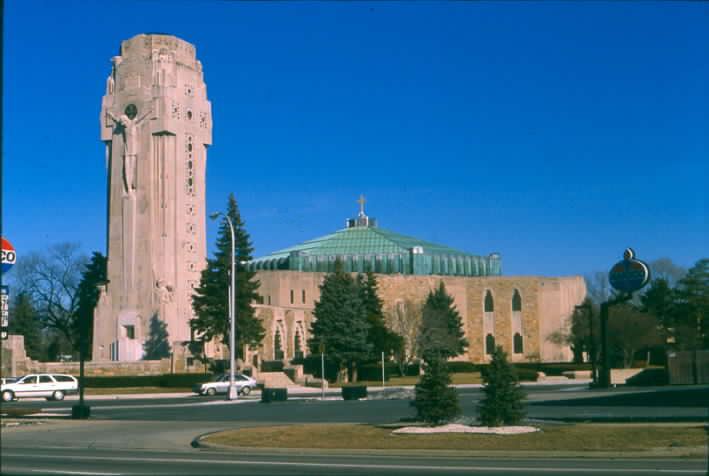Phone +1 248-541-4122 | ||
 | ||
Similar Cathedral of the Most Blessed, Basilica of the National, Our Lady of the Rosary Roman C, Saint Paul Catholic Church, Sacred Heart Major Se | ||
National shrine of the little flower basilica project
National Shrine of the Little Flower Basilica Catholic Church in Royal Oak, Michigan is a well known Roman Catholic church and National Shrine executed in the lavish zig-zag Art Deco style. The structure was completed in two stages between 1931 and 1936. The sanctuary stands at 2100 West Twelve Mile Road at the northeast corner of Woodward Avenue and is a parish of the Roman Catholic Archdiocese of Detroit. Construction was funded by the proceeds of the radio ministry of the controversial Father Charles Coughlin who broadcast from the tower during the 1930s.
Contents
Father Coughlin was an early supporter of the New Deal programs of Franklin D. Roosevelt before becoming one of Roosevelt's harshest critics. In 1934 he announced a new political organization called the National Union for Social Justice. He wrote a platform calling for monetary reforms, the nationalization of major industries and railroads, and protection of the rights of labor, issuing antisemitic commentaries and supporting some policies of Adolf Hitler and Benito Mussolini. Many American bishops as well as the Vatican did not sanction his views, in fact the V-12 Navy College Training Program was run by Catholic Universities during WW2. V-12 was similar to the Army Specialized Training Program (ASTP) which ran from 1942 to 1944 with a goal of providing more than 200,000 Army officers. After the outbreak of World War II in Europe in 1939, it was the Roosevelt administration that finally forced the cancellation of his radio program and forbade the dissemination through the mail of his newspaper, Social Justice. The American public responded with "contributions which have flooded into his bank account as a result of these talks runs into thousands of dollars weekly.The membership ran into the millions, but it was not well-organized at the local level.
History
Named in honor of Saint Thérèse de Lisieux (who was also known as the Little Flower), the church was first built in 1926 in a largely Protestant area. Two weeks after it opened, the Ku Klux Klan burned a cross in front of the church. The original wood structure was destroyed by a fire March 17, 1936. Construction of the new building started in 1931 and ended in 1936. Its completion was spurred by the destruction of the old structure and it employed large amounts of copper and stone to execute the designs of architect Henry J. McGill, of the New York firm of McGill and Hamlin.
Pope Francis designated the Shrine a minor basilica January 31, 2015.
Architecture
A dramatic limestone Art Deco tower called the Charity Crucifixion Tower, completed in 1931, features integrated figural sculptures by Rene Paul Chambellan, including a large figure of Christ on the cross, 28 ft (8.5 m) high on the Woodward Avenue façade. It was built as a response to the Ku Klux Klan as a "cross they could not burn". The sides and rear feature windows inside the crucifix which can be lit from within. At the upper corners of the tower are symbols of the Four Evangelists. Carved below the feet of the figure of Christ are the Seven Last Words. Just below them is a doorway with "Charity" and "Christ Crucified" carved above it. On the sides of the doorframe are depictions of items associated with the Passion. The doorway leads to a small balcony which can serve as a pulpit. On the front are carved depictions the Archangels Jophiel, Raphael, Michael, Gabriel and Uriel. The pulpit is flanked by depictions of John the Apostle and the Virgin Mary to the left and a Roman Centurion holding a spear and Mary Magdalene on the right. Across the terrace facing the crucifix a depiction of Saint Thérèse of Lisieux is carved into the surrounding wall. This sculpture is also by Chambellan.
Behind the tower are doors leading to large chapel that connect the tower with the main sanctuary. The altar of the chapel is within the base of the tower. The octagonal nave seats three thousand on two levels, with the altar in the center. The main building is granite and limestone, with exterior and elaborate interior sculptural work by Corrado Parducci, including a lectern and Stations of the Cross, and hand-painted murals by Beatrice Wilczynski. The stunning octagon-shaped granite baptismal font was designed by renowned liturgical artists Robert Rambusch and Mario Agustin Locsin y Montenegro.
In 1998, the United States Bishops' Conference declared the site a National Shrine, one of only five in the country according to the church's web site.
Controversy
Fr. Coughlin broadcast his popular radio program from the tower of the Basilica. As the 1930s wore on his broadcasts became increasingly anti-Semitic. After the start of World War II, the Roosevelt administration worked to shut him down and managed it by convincing his bishop to instruct him to stop.
